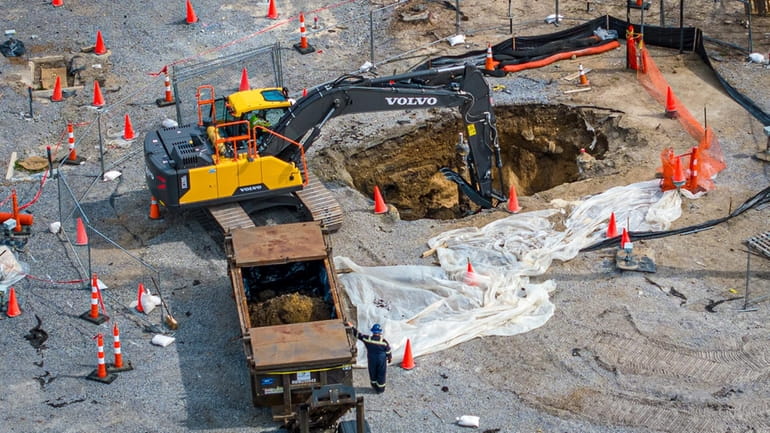Toxic chemicals at Bethpage park, battery storage sites, West Islip student with gun, bullets

Workers seek more 55-gallon drums buried at a former Grumman Aerospace dumping site in Bethpage Community Park on April 17. Credit: Newsday/J. Conrad Williams Jr.
Toxic park situation can be teaching tool
The discovery of canisters containing toxic chemicals at Bethpage Community Park is concerning [“More drums pulled from Bethpage park,” News, April 18]. Whatever actions are needed to remediate this should be undertaken.
The property was donated in good faith to the town. Culpability is second to cleanup. Whether Grumman Aerospace knew that what they buried and released would cause harm is now history.
Northrop Grumman and the U.S. Navy have been working on cleanup and should continue
to do so.
Use this problem to educate the public and be a catalyst to inspire the public, students, scientists, engineers, academia and industry to devise solutions for problems like this. Those in government must use their power to facilitate this.
Solutions devised can be used elsewhere, too. Our landfills and septic systems are of monumental importance and concern. Their residual problems cannot be ignored. Is it the residual cost of freedom?
Without the contributions that Grumman made during World War II to help defeat the Axis powers, you and I may not be here today. Consider this problem, as unwelcome as it is, to remind us that the price of freedom is never-ending. This is but one of the harsh side effects. It can be remediated.
— Reid Bielecki, Patchogue
When do the residents of Bethpage get a say? The finger-pointing between the Department of Environmental Conservation, Northrup Grumman and the Town of Oyster Bay has gone on for decades and has to stop. The focus should be on the residents. We are tired of the park being used as a political stunt. It’s time for more action.
Give us our community park back so the stigma of the plume can be lifted once and for all.
— John Coumatos, Bethpage
There is concern about trichloroethylene (TCE) leaching into the soil, but I can buy a gallon of it on Amazon for $75. What does that say about us?
— Bruce W. Miller, Huntington
Keep battery sites moving along
Battery storage facilities are new to Long Islanders and, naturally, fires concern us [“Oyster Bay halts battery storage sites,” Long Island, April 11]. But those are not reasons to stall battery storage development here, especially when it’s growing all over the country.
Battery storage plants adhere to strict fire safety standards. Local firefighters are trained in specific techniques to handle any fires, which typically burn out within their individual enclosures without damaging either the rest of the facility or adjacent property.
We need battery storage to make our electric grid more resilient and to keep our power bills down. They act as generators to keep the lights on when lines to the power station go down. They store power at low demand and make it available at peak demand.
Even with all the gas generating plants we have, utility companies are often unable to handle surges in demand. Battery storage lets us shift our reliance from polluting gas plants to renewable power. More than the beauty of Long Island is at stake if we don’t take these steps.
— Alexa Marinos, North Babylon
Lots of towns want to hit the brakes on battery storage. It’s both necessary and reasonable to take fire risk seriously. But it’s also necessary to put it in perspective.
No one was injured and no toxins were released in the three New York State battery storage fires. The same cannot be said of any number of gas explosions.
Certainly, battery storage fires cannot be handled by conventional means. That’s why firefighters are trained in the distinct skills they will need before battery storage facilities are activated, as was evident in the East Hampton fire.
Battery storage is designed to lower our electric bills as we transition to offshore wind by storing cheap power during low usage times and supplying it at peak times when it would otherwise cost more. Batteries deliver grid resiliency, especially during storms that down power lines.
Nothing is risk-free. But I would take a containable battery storage fire over an explosion from a gas leak any day.
— Morgan McLenan, Freeport
Why does a student bring gun to school?
A West Islip High School student brings a handgun and 25 bullets into the high school, and his attorney says, “There is absolutely no evidence and no criminal intent that my client was going to cause any physical injury to anyone” [“Not guilty plea for gun in school,” News, April 17].
I would like his attorney to tell us why this 17-year-old student had the weapon in school. Was it for “show and tell?”
— Vincent Stephan, Sayville
WE ENCOURAGE YOU TO JOIN OUR DAILY CONVERSATION. Just go to newsday.com/submitaletter and follow the prompts. Or email your opinion to letters@newsday.com. Submissions should be no more than 200 words. Please provide your full name, hometown, phone number and any relevant expertise or affiliation. Include the headline and date of the article you are responding to. Letters become the property of Newsday and are edited for all media. Due to volume, readers are limited to one letter in print every 45 days. Published letters reflect the ratio received on each topic.
